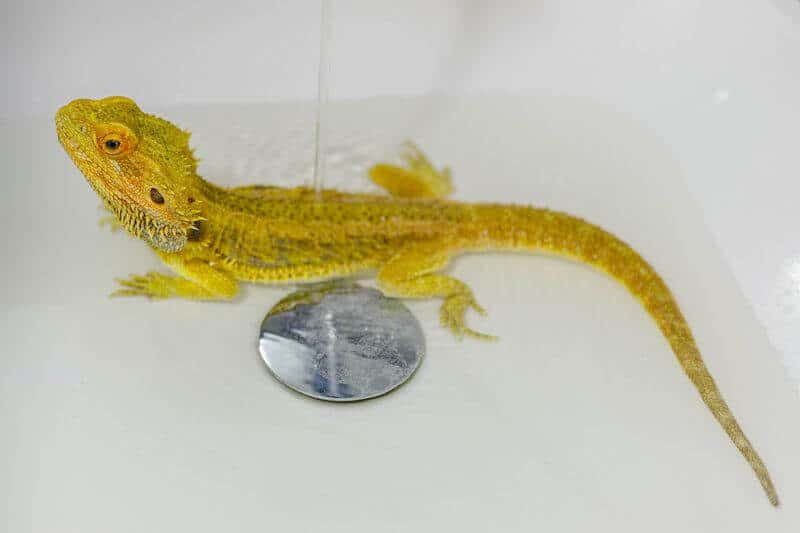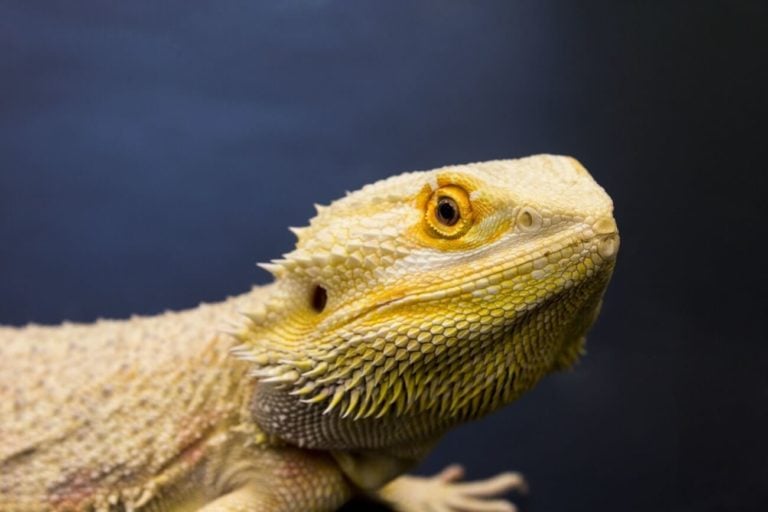Many new owners don’t know if their bearded dragon can swim or not, and don’t want to take any chances with the safety of their pet. And that’s a good thing!
We’ll put your mind at ease with this informative guide about if bearded dragons can swim well, if they like it, and safety precautions you should take.
Table of Contents
Can Bearded Dragons Swim?
Bearded dragons can have a hit-or-miss relationship with water. Some love to soak it up in a bowl, while others will fight you tooth and nail to avoid getting wet! It’s an interesting personality quirk that varies from one beardie to the next.
Despite how your reptile feels about water, you should know that bearded dragons can swim!
They rarely get the opportunity to do so in the wild, but these reptiles are fully capable of swimming when they need to. It’s instinctive, and lizards will use the ability whenever they need to cross a pond or evade a would-be predator.
In captivity, swimming is a great way to cool off and get much-needed exercise.
When bearded dragons swim, they exhibit behaviors similar to alligators or crocodiles. They lack webbed feet, so they rely on their tails to glide forward. You’ll also notice these lizards often tuck their legs in as they start using the tail as a quasi-fin. However, you may also catch them using their limbs as paddles to swim faster or change directions.
Interestingly enough, bearded dragons are surprisingly buoyant. They inhale air to stay afloat! While not the most graceful swimmers of the animal kingdom, beardies do just fine in the water.
Do Bearded Dragons Like To Swim?
Just because a bearded dragon can swim doesn’t mean that they necessarily enjoy it. As mentioned earlier, their affinity for water comes into the equation. It’s like bath time: Some enjoy it, and some don’t.
You should never force your beardies to go for a swim. If you attempt to plop them in the water, they may panic and experience stress. Your lizard may even grow fearful of you, and the resentment of water will only grow stronger.
Before you consider going for a swim with your bearded dragon, pay attention to how they react during soaks and baths. If they don’t mind the water, there’s a good chance they’ll enjoy it. However, it’s up to you to read your lizard and do what’s best for them.
If your bearded dragon does enjoy swimming, you have a lot of great times ahead!
Swimming is a fantastic way to spend time with your lizard. It’s a bonding experience and is often quite fun for these reptiles. Going for a dip is a nice change of pace and can be enriching in many ways.
Not only does it provide exercise, but swimming can also help with shedding, alleviate constipation, and more.
Can Baby Bearded Dragons Swim?
Baby bearded dragons can swim just like adults. It’s something that comes naturally to this reptile.
That said, babies aren’t as capable as their adult counterparts. As a result, swimming sessions should be shorter. You must also keep an eye on these animals to make sure they don’t struggle.
Younger beardies can’t store as much air as the older ones. Therefore, they have limited buoyancy in the water.
There’s also the issue of body temperature. All bearded dragons are cold-blooded and need to thermoregulate. However, adults are better at storing body heat than babies and juveniles.
Swimming for too long in a cold wading pool will negatively impact a baby bearded dragon. If you neglect to take them out, the drop in body temperature could be fatal!
The good news is that babies seem to enjoy it as much as adults. That early exposure is also a great way to ensure that your lizard’s relationship with water is healthy moving forward to maturity.
How Long Can Bearded Dragons Hold Their Breath?
In most cases, you’ll only ever see your bearded dragon swim at the surface. Typically, these lizards keep their heads above water. They may duck underneath the surface occasionally, but they like to stay as close to the surface as possible.
At most, bearded dragons will swim to depths of about a foot. That’s a good thing! It means you don’t need to provide deep waters for these reptiles to have fun.
You may be wondering how long these creatures can hold their breath.
Believe it or not, the average bearded dragon can stay underwater for about 10 to 15 minutes. That’s more than enough time to evade capture in the wild. They can duck out of sight until a predator loses interest before resurfacing and making their way back to land.
Staying underwater for more than 15 minutes will lead to drowning.
Fortunately, most beardies in captivity won’t even attempt anything close to that! As mentioned earlier, they prefer surface swimming and typically only use underwater swimming to survive when necessary.
Is It Fine To Let Bearded Dragons Swim In A Pool?
If you have a backyard pool, you may feel tempted to let your beardie go for a swim there. However, you might want to reconsider.
Think about the chemical composition of your pool water. What treatments do you use to keep it clean? If you’re like most pool owners, you likely use chlorine.
Chlorine is a fantastic way to keep bacteria at bay, prevent algae, and keep that water sparkling blue. But at the end of the day, it’s a chemical that can harm your bearded dragon!
Light chlorination usually doesn’t cause any issues. Your tap water may have a small amount of chlorine that’s perfectly safe for human consumption. But is that a risk you want to take with your bearded dragon?
Pools often have higher concentrations of chlorine. In many cases, there’s enough to make the water smell unmistakably chemical-laden. It’s far too much for a bearded dragon.
Here’s why:
A bearded dragon swimming in a pool of chlorine-filled water will likely cause mass irritation. Humans who spend too much time in the pool often have to deal with irritated eyes, itchy skin, and stringy hair. Imagine what it does to a reptile!
The chemicals dry out the skin, causing irritation that will drive your lizard crazy. It may even make things more difficult for your bearded dragon during shedding periods. Sometimes, the chlorine is enough to make the lizard know that something’s off, resulting in elevated stress levels.
As if those risks weren’t bad enough, you also have to worry about the chemical-filled water getting into your lizard’s system.
Many bearded dragons lap up water as they swim. But even if they don’t do that, they may absorb moisture as they soak. That presents potential health problems you do not want to deal with for the sake of a swim.
The same goes for saltwater pools. While salt is generally better for human skin due to the lack of chlorine, salt can be just as drying and irritating to a bearded dragon!
If you want to set up a swimming pool for your bearded dragon, it’s best to set up a separate space without chlorine. You can invest in a kiddie pool or buy yourself a full-sized pool. Remember: These lizards don’t need much depth to have fun, so a wading pool will do just fine.
After filling the pool, add a reptile-safe water conditioner. This liquid treatment will remove chloramines and ammonia, making the water safe for your lizard to enjoy.
Safety Precautions To Remember While Letting Them Swim
Establishing a safe space for your bearded dragon to swim is only half the battle. While these animals know how to swim, you must observe and take safety precautions.
The first thing you need to do is ensure that the water temperature is comfortable. Bearded dragons are cold-blooded animals, and a dip in a freezing-cold pool will only put their health at risk.
Ideally, warm or lukewarm water is best. Use a thermometer to check the temperature. Anything between 90 and 100 degrees is ideal.
If you’re using a small wading pool or a large tub, you can use an aquarium-style submersible heater to bring the water up to temperature.
Next, ensure that your bearded dragon has a place to rest.
Swimming takes up more energy than most people realize. Think about the last time you did a few laps! It’s physically draining, and you must provide a resting spot to ensure your lizard doesn’t tire itself out.
Fortunately, this step is easy. You can toss in a few pool floats or install a perch. Whenever your beardie gets tired, they can head over to those objects to take a breather.
When it’s time to swim, ensure that your lizard is comfortable and ready. Never force them into the water if they don’t want to go in.
As they swim around, monitor your lizard at all times. Stay with them the entire swimming session, and always be ready to jump into action if necessary. It only takes a second for disaster to strike.
Your lizard can get tired, lose their buoyancy, and quickly drown. You need to be there to bring them back to the surface if that ever happens.
After a good swim, dry your bearded dragon off and keep them warm. Wrap your lizard in a warm towel and pat them dry. Then, place them under the basking light to avoid post-swim chills.
Conclusion
Bearded dragons can swim quite well, which comes as a surprise to many people. But if you get them in the water (in a safe environment), these reptiles will be quite comfortable.
So if you think your bearded dragon likes to swim, consider giving them more opportunities to do so!



